★★★½
“The final countdown.”
 The tapes for this show – it’s a 2-cassette set – came from a friend in Hong Kong; I have to say, when I saw the official retail price, was rather gobsmacked. Y180,000, which is about $150! And that’s in 1994 money… I can only presume it was intended for the rental market rather than the fan. Needless to say, I didn’t pay so much for it…
The tapes for this show – it’s a 2-cassette set – came from a friend in Hong Kong; I have to say, when I saw the official retail price, was rather gobsmacked. Y180,000, which is about $150! And that’s in 1994 money… I can only presume it was intended for the rental market rather than the fan. Needless to say, I didn’t pay so much for it…
Still, financial considerations aside, 1993 may have been the year when Japanese women’s wrestling was at its peak. Perhaps the greatest single event ever, Dreamslam, took place in April, pitting the best wrestlers against each other, regardless of what wrestling company they worked for. The St. Final show in December, was a similar cross-promotional attempt to create a mega-event, and took place in Tokyo’s Sumo Hall, before a crowd of 11,500.
Leo Kitamura/Otaku Hozumi vs. Tomoko Watanabe/Chikako Shiratori. Not really much to say about this opening match, which was clearly a warm-up; the crowd were still coming to their seats. Tomoko Watanabe would go onto much greater things (particularly as part of the ZAP tag-team), and Shiratori would also move on, but Kitamura and Hozumi vanished off the radar as far as I can tell. Next up after this was a midget wrestling bout – it says something that it was considered worthy of a higher place on the card!
Chaparrita ASARI vs Candy Okutsu (JWP). Here is another case where the contenders would go on to better things, and their feud for the WWWA Super-lightweight title in the late 90’s is well-regarded. But even now, and despite both wrestlers having only made their first appearances the previous year, this bout had its moments, though it was pretty variable. The boston crabs Okutsu put on ASARI were spine-poppingly good, while ASARI was athletic and agile, in a fast-paced bout. She failed to hit her finisher, landing head-first after a Skytwister Press, and the rapid pin thereafter by Okutsu was probably very welcome.
Sakie Hasegawa/Kaoru Ito vs. Miki Handa/Yasha Kurenai (LLPW). This one wasted no time, the combatants going at it before the introductions were even completed. The bout was a good illustration of the difference between single bouts and tag teams; both sides worked well together, both to attack their opponents, and making saves when their partner was in trouble. I note with interest that the referee was also from the LLPW – the shirt kinda gave it away – so it was no surprise when Handa and Kurenai took the win. However, when the “visitors” win the undercard bouts, it’s often a clue that the main events will go to the home federation…
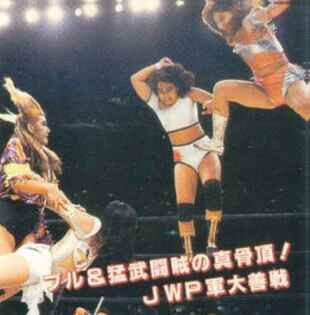 Bull Nakano/Mima Shimoda/Etsuko Mita vs. Cuty Suzuki/Plum Mariko/Hikari Fukuoka (JWP). This had the makings of a squash match, with the JWP girls out of their depth. However, when Nakano wasn’t in the ring, it was well-balanced. Fukuoka in particular performed like ring-icon Manami Toyota, even using Toyota’s signature rolling cradle move. Suzuki took a lot of punishment, and her gold armour costume was cool, while Mariko (later in her career, she would die after a bout) helped out with good assists. Shimoda and Mita kept pace nicely, but Nakano ruined things by brushing off all attacks, destroying their impact by her refusal to sell. No surprise her team got the win, but this bout was one player short of being memorable.
Bull Nakano/Mima Shimoda/Etsuko Mita vs. Cuty Suzuki/Plum Mariko/Hikari Fukuoka (JWP). This had the makings of a squash match, with the JWP girls out of their depth. However, when Nakano wasn’t in the ring, it was well-balanced. Fukuoka in particular performed like ring-icon Manami Toyota, even using Toyota’s signature rolling cradle move. Suzuki took a lot of punishment, and her gold armour costume was cool, while Mariko (later in her career, she would die after a bout) helped out with good assists. Shimoda and Mita kept pace nicely, but Nakano ruined things by brushing off all attacks, destroying their impact by her refusal to sell. No surprise her team got the win, but this bout was one player short of being memorable.
Kyoko Inoue/Takako Inoue/Yumiko Hotta vs. Eagle Sawai/Rumi Kazama/Harley Saito (LLPW). Onto the second tape, having got the appetisers out of the way. Things still not quite at full boil, as this match was dominated by the strength brigade of Kyoko Inoue, Hotta and Sawai – the other three were next to invisible. Hotta is infamous for her kicks, and they’re not something I’d like to receive, while Sawai gave a good account of herself, flinging Inoue across the ring. But it lacked much in the way of variety, though Kyoko Inoue’s agility was impressive for someone of her size.
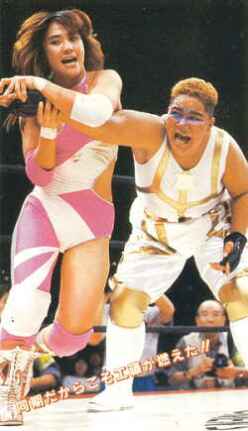 Aja Kong vs. Megumi Kudo (FMW). It says something that a match for the WWWA World Title wasn’t the main event, or even the second one. We know how this one’s gonna go: Kudo getting punked repeatedly. Wrong. Had quite forgotten Kudo knows how to wrestle, easy to do when she’s fighting talentless thugs like Shark Tsuchiya. Kong was playing the straight champion, at least until Kudo took advantage – then the gloves came off, Kong giving her opponent no slack, with brutal kicks and slaps.
Aja Kong vs. Megumi Kudo (FMW). It says something that a match for the WWWA World Title wasn’t the main event, or even the second one. We know how this one’s gonna go: Kudo getting punked repeatedly. Wrong. Had quite forgotten Kudo knows how to wrestle, easy to do when she’s fighting talentless thugs like Shark Tsuchiya. Kong was playing the straight champion, at least until Kudo took advantage – then the gloves came off, Kong giving her opponent no slack, with brutal kicks and slaps.
Initially, this was mat-based, which seemed like a bad move for the much smaller Kudo, but when Kudo started locking in the cross arm-bars, the balance shifted. Her problem was keeping Kong from heading for the ropes, but frequent repetition (and Kong’s excellent selling of the moves) made the possibility of an upset quite plausible. Kong hit back with power moves, and Kudo switched to trying for falls…a fatal mistake. :-) She would have got one but the ref had been “knocked out” – a rare stunt in Japan – and we all know that means you’re gonna lose. Kudo seemed genuinely tearful in the post-bout interviews.
Dynamite Kansai/Mayumi Ozaki (JWP) vs. Manami Toyota/Toshiyo Yamada. This was for the WWWA tag bout, but was just one fall, rather than the usual three. Probably wise, as the pace was totally frenetic. My notes for this one peter out after about 10 minutes, since I gave up trying to write because something was always happening. I like well-balanced bouts, and this was one which could have ended at almost any time, in either direction – both sides had one high-flyer (Ozaki & Toyota), and one powerhouse (Kansai & Yamada), giving plenty of variety and scope for action of all sorts.
Toyota was likely the star, not just for the pounding she took, or even her usual suicidal athleticism – though the moonsault from the top rope to the arena floor was memorable – but because she seemed really into the contest, screaming like a banshee. This in no way should be taken to indicate slackness on anyone else, as they all played their parts. Kansai and Yamada punted each other ferociously, the latter also hitting Ozaki with a seemingly-endless Giant Swing. The only weakness was an ending which seemed sloppy and not up to the amazing standard of the rest of the bout, but this contest still merited an immediate rewind and repeat.
Akira Hokuto vs. Shinobu Kandori. Can you imagine the WWE headlining a pay-per-view with a non-title bout? But these two had a ferocious rivalry – their Dreamslam I match was voted the best contest of the 90’s in an Internet poll – and any contest between these two was an obvious attraction. Within ten seconds Hokuto was bleeding badly from the mouth, after trading lethal punches with Kandori, and you just knew this was going to be a brawl from hell, rather than an exercise in scientific wrestling.
As such, while you couldn’t knock the intensity on view here, couldn’t help shake the feeling that we’d left the wrestling world behind, and were now operating somewhere between pro boxing and Brawlin’ Broads. Kandori had a nice arrogance though, deliberately holding back on her kicks and, at one point, applying a submission hold on Hokuto then letting go with a waggle of her finger, as if to say, “Too easy!”. But it was just too close to an episode of Jerry Springer to make this a classic in my eyes.
Overall, this is a solid tape. Perhaps only the WWWA tag team bout would make it onto any best-of compilation – but even the worst is still better than 90% of the contests in the WWE these days. Even though it’s only a single event, it demonstrates the breadth and depth of Japanese women’s wrestling, with a variety of styles, looks and attitudes which we in the West can, for the moment, only dream of enjoying.
Star: Akira Hokuto, Shinoba Kandori, Dynamite Kansai, Manami Toyota
 If ever a movie was condemned by the medium, this is it – it’s badly dubbed, cropped to oblivion, and the print looks as if it has recently been used as kitty litter. Just what DVD was invented for… Plotwise, there’s certainly nothing new. Shiomi plays the daughter of a kung-fu master (Chiba) who was crippled by his rival (Ishabashi) in a spat over a job. He retires to New York to plot revenge, using his daughter as his weapon. After the traditional, getting-beaten-up-repeatedly training, she returns to Japan, wastes no time in making a nuisance of herself and everything heads relentlessly towards the big showdown.
If ever a movie was condemned by the medium, this is it – it’s badly dubbed, cropped to oblivion, and the print looks as if it has recently been used as kitty litter. Just what DVD was invented for… Plotwise, there’s certainly nothing new. Shiomi plays the daughter of a kung-fu master (Chiba) who was crippled by his rival (Ishabashi) in a spat over a job. He retires to New York to plot revenge, using his daughter as his weapon. After the traditional, getting-beaten-up-repeatedly training, she returns to Japan, wastes no time in making a nuisance of herself and everything heads relentlessly towards the big showdown.




 Okay, pardon me if I’m confused. What the IMDB says is the plot for Metropolitan Police Branch 82 is actually Tokyo Blue: Case 1. However, there are multiple parts to the series, and I
Okay, pardon me if I’m confused. What the IMDB says is the plot for Metropolitan Police Branch 82 is actually Tokyo Blue: Case 1. However, there are multiple parts to the series, and I  While this is live-action, Oshii is best known for his anime work, such as Ghost in the Shell. That also had an action heroine, great visual style and lost its way in philosophical navel-gazing. There, it was the nature of self – here, it’s the nature of reality. Set in Poland, which may be a first for a Japanese film, the heroine, Ash (Foremniak), is addicted to an illegal computer game called Avalon. When she hears about the existence of a special level in it, she’ll stop at nothing to find the entrance. But, for her, the line between life and pastime is becoming more and more blurred…
While this is live-action, Oshii is best known for his anime work, such as Ghost in the Shell. That also had an action heroine, great visual style and lost its way in philosophical navel-gazing. There, it was the nature of self – here, it’s the nature of reality. Set in Poland, which may be a first for a Japanese film, the heroine, Ash (Foremniak), is addicted to an illegal computer game called Avalon. When she hears about the existence of a special level in it, she’ll stop at nothing to find the entrance. But, for her, the line between life and pastime is becoming more and more blurred…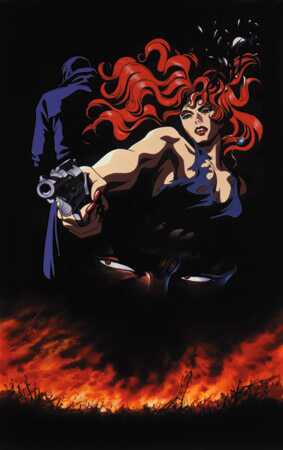 Four stars but no seal of approval? That’s because this is about the most wildly variable animated film I’ve seen. The story and characters are great, but the frequent sex scenes are incredibly tedious and clearly put in solely for the teenage male fan (all pneumatic breasts and moaning). It’s rare for me to say this, but they are genuinely gratuitous, and the film could have coped fine without them.
Four stars but no seal of approval? That’s because this is about the most wildly variable animated film I’ve seen. The story and characters are great, but the frequent sex scenes are incredibly tedious and clearly put in solely for the teenage male fan (all pneumatic breasts and moaning). It’s rare for me to say this, but they are genuinely gratuitous, and the film could have coped fine without them.
 Watching this dubbed was, for once, viable since despite its Japanese origins, it’s firmly set in and around Chicago. So we did sit through some of it in English, but the accents were woefully Cal-girl and thus we’d recommend sticking with the Japanese, even more unlikely though it might be. That out of the way, this is an action-packed romp, in three episodes but effectively one story. Rally Vincent and May Hopkins, one a crack marksman, the other an explosives expert, own a gun store, but are blackmailed by the ATF into helping nail an arms ring. It’s not as simple as it seems, since the perps have connections at a high level, and the services of a former Soviet Special Forces hitwoman.
Watching this dubbed was, for once, viable since despite its Japanese origins, it’s firmly set in and around Chicago. So we did sit through some of it in English, but the accents were woefully Cal-girl and thus we’d recommend sticking with the Japanese, even more unlikely though it might be. That out of the way, this is an action-packed romp, in three episodes but effectively one story. Rally Vincent and May Hopkins, one a crack marksman, the other an explosives expert, own a gun store, but are blackmailed by the ATF into helping nail an arms ring. It’s not as simple as it seems, since the perps have connections at a high level, and the services of a former Soviet Special Forces hitwoman.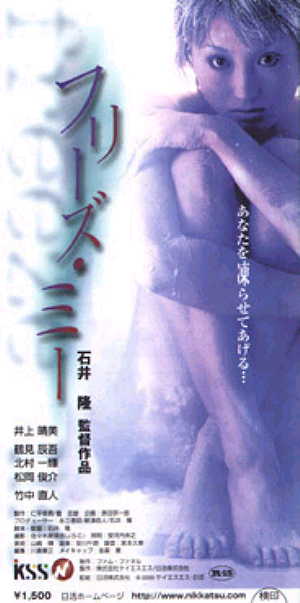 Five years after a vicious gang-rape, Chihiro has somewhat recovered, with a new apartment, job and boyfriend. But one of the attackers turns up on her doorstep, with a video of the assault, and threatens to destroy her new life. He moves in. Worse yet, his colleagues are on their way. What’s a girl to do? If you answered “kill the bastard, stuff him in her freezer, then wait for the other two rapists”… you’ve clearly seen this before.
Five years after a vicious gang-rape, Chihiro has somewhat recovered, with a new apartment, job and boyfriend. But one of the attackers turns up on her doorstep, with a video of the assault, and threatens to destroy her new life. He moves in. Worse yet, his colleagues are on their way. What’s a girl to do? If you answered “kill the bastard, stuff him in her freezer, then wait for the other two rapists”… you’ve clearly seen this before.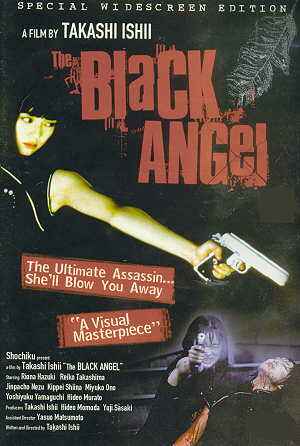 The first half of this is quite excellent. A young girl, Ikko, daughter of a Yakuza boss, sees her parents murdered on the orders of her step-sister but is rescued by the Black Angel (Takashima), a female assassin, and escapes to America. 14 years later, she returns (Hazuki), calling herself the Black Angel and starts wreaking revenge on those responsible – who retaliate by calling in the
The first half of this is quite excellent. A young girl, Ikko, daughter of a Yakuza boss, sees her parents murdered on the orders of her step-sister but is rescued by the Black Angel (Takashima), a female assassin, and escapes to America. 14 years later, she returns (Hazuki), calling herself the Black Angel and starts wreaking revenge on those responsible – who retaliate by calling in the  Scorpion’s Revenge is an understandable, if not really helpful, retitling of a film called Sasori in USA; as this suggests, it attempts to add an exotic flavour by setting things in an uncivilised and/or dangerous locale. Foreigners are, after all, inherently evil, and do far worse things to our women than we ever would. This isn’t new: many of Roger Corman’s 1970’s WiP movies were shot in the Philippines, albeit partly for cost reasons.
Scorpion’s Revenge is an understandable, if not really helpful, retitling of a film called Sasori in USA; as this suggests, it attempts to add an exotic flavour by setting things in an uncivilised and/or dangerous locale. Foreigners are, after all, inherently evil, and do far worse things to our women than we ever would. This isn’t new: many of Roger Corman’s 1970’s WiP movies were shot in the Philippines, albeit partly for cost reasons.